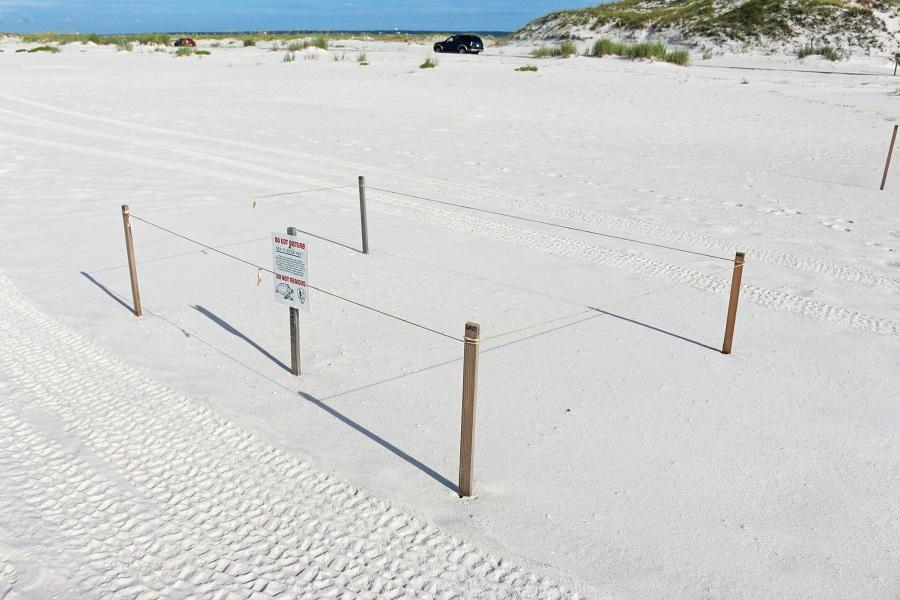
Sea turtle nest at Gulf Islands National Seashore / Erika Zambello.
Gulf Islands National Seashore stretches 160 miles along the coast of Florida and Mississippi, comprising 12 distinct areas. From the Choctawhatchee Bay waters to historic Fort Pickens to the barrier islands of Mississippi, this seashore covers a wide range of habitats and cultural landmarks. In 2018, 59 Loggerhead sea turtles nested in the park.
Four species of sea turtle nests on the Florida Panhandle: the Loggerhead, Leatherback, Kemp’s Ridley, and Green. However, Loggerhead nests are by far the most common. During the night, females use their powerful flippers to pull themselves up on the sand, digging giant holes in which to lay their eggs before retreating to the waves once more. Come morning, their tracks are the tell-tale giveaway that turtles have chosen the sites for their nests. That’s where Mark Nicholas comes in.
Nicholas has been a sea turtle monitor for years. Each morning, from May until October, he, staff, or volunteers ride the beach looking for turtle nests. When they find one, they mark it carefully.
When they do hatch, Nicholas and his team are on the scene.
“We’ve got to go to every [nest],” he explains, “because we have a really bad problem with disorientation from light pollution, so basically we have to be there for every nest that hatches to make sure they get in the Gulf.”
Turtle eggs usually hatch at night, and this can sometimes make for long vigils.
In addition to light pollution, these nests must also contend with a variety of predators. Fox, coyote, raccoon, and even armadillos will feast on eggs if they get the chance.
“Coyotes are a huge problem for our shorebird nesting,” Nicholas says. However, “they haven’t quite figured out the turtle nesting stuff yet… if and when they do figure it out we’re going to have some major issues because they’re really smart and the potential is there for us to have a lot of problems with them.”
He concludes, “It’s only a matter of time ‘till they figure it out.”
For Nicholas, his favorite part of the turtle monitoring come when the eggs hatch. “Occasionally you get to come across the females when they’re nesting,” he adds, “Which is pretty cool as well.”
Unfortunately, 2018 was a difficult year for Gulf Islands National Seashore turtles.
"Overall hatch success was 27.8 percent; this was very low," explains Brent Everitt, chief of communications at the park. "Tropical Storm Gordon and Hurricane Michael had a significant impact on sea turtle nests in the park this year. In particular, Gordon eroded out a lot of nests, thus the low success. Our biologists did observe predation issues as well in the Fort Pickens area of the national seashore."
The park also assists nearby public lands in their sea turtle nest monitoring, and nearby areas had greater success: "The park service assists Escambia County, Florida, by conducting turtle monitoring on Pensacola Beach," Everitt continues in an email. "This area had 21 loggerhead nests and two Kemp's Ridley nests. Nests occurred earlier on PB for some reason, so Gordon wasn't as large of an impact. The hatching success was 51.7 percent."
Thinking about a visit next summer? There are a lot of things you can do to keep the turtles safe!
1) If you see a turtle during the day, don’t touch it. Contact Gulf Islands National Seashore staff.
2) If you dig holes in the sand, make sure you fill them in before you leave. Sea turtles can get stuck.
3) If you are on the beach at night, avoid flashlights or other light sources. If you have to use them, cover the glass with red film (turtles are less sensitive to this type of light).
4) Admire the nests, but don’t step across the ticker tape or rope.
5) Clear away litter – turtles might think it’s food.
6) Encourage local governments and businesses to install turtle friendly lights to reduce light pollution.

 Support Essential Coverage of Essential Places
Support Essential Coverage of Essential Places






